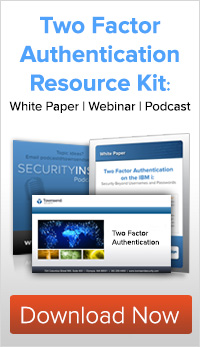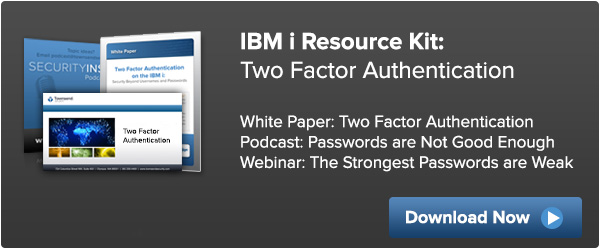Because passwords can easily be compromised, they are considered to be a weak layer of security if used alone.
 The use of two factor authentication (2FA) provides an added layer of security beyond just standard username and password credentials. Almost all connections to the IBM i platform are over a network (LAN or WAN), and they are rarely hardwired connections. Because networks are so susceptible to snooping attacks, even LAN connections should be treated like remote access. Remote access to networks containing critical payment, patient information, or financial records can be protected with two factor authentication using your mobile phone to receive SMS and voice verification authentication codes with an easy to deploy, cost effective 2FA solution for the IBM i platform!
The use of two factor authentication (2FA) provides an added layer of security beyond just standard username and password credentials. Almost all connections to the IBM i platform are over a network (LAN or WAN), and they are rarely hardwired connections. Because networks are so susceptible to snooping attacks, even LAN connections should be treated like remote access. Remote access to networks containing critical payment, patient information, or financial records can be protected with two factor authentication using your mobile phone to receive SMS and voice verification authentication codes with an easy to deploy, cost effective 2FA solution for the IBM i platform!
Protecting access with two factor authentication adds identity assurance and significantly reduces risk of unauthorized access in industries covered by PCI DSS, HIPAA/HITECH, and GLBA/FFIEC compliance regulations.
-
PCI DSS section 8.3 requires two factor authentication for remote access to systems containing credit card information.
-
HIPAA/HITECH act recommends two factor authentication to mitigate the risk of lost or stolen personal health information.
-
FFIEC guidance also calls for the use of two factor authentication to strengthen systems in the financial industry and strengthen banking websites against a financial fraud.
Although there are varying levels of enforcement, it is clear that two factor authentication plays a growing and critical security role in both compliance and following best practices.
Since launching Alliance Two Factor Authentication in January, we have had a number of questions about the product and thought we would share them here (along with the answers!)
Q: Does Two Factor Authentication integrate into my already existing Single Sign On (SSO) environment?
A: Yes! Because the authentication process takes place after the login is complete, it will help strengthen the security around SSO.
Q: In which countries is 2FA available?
A: Two Factor Authentication is a global product. We are partnered with Telesign, which has a network of over 120 countries and the ability to work with 90+ languages to support generation of SMS messages.
Q: What profile security is required to run 2FA?
A: As a native IBM i solution, you assign normal security controls during installation. End-users have to have use-authority to the library to use the services.
Q: Does your 2FA solution require a mobile app (like Google does) to generate the authentication codes?
A: Since our solution is fully self-contained and installed on the IBM i platform, it does not require a mobile application. The 2FA solution talks over a secure connection to the Telesign service, resulting in a pincode delivered to your mobile device as a SMS text message, or to your standard phone as a voice message.
Q: What if I don’t have access to a phone?
A: In case you don't have a mobile phone, or are in a location where you can't get cell service, your IBM i system administrator can record up to four additional voice phone numbers per user. This gives you a lot of flexibility for putting in phone numbers for home, work, cell with either the text or voice option. In the rare chance you may be someplace without access to any type of phone, Alliance 2FA provides up to 5 one-time codes for use when the phone services are not available. These are randomly generated numeric PIN codes a user has access to, that gives them the ability to authenticate even if they don't have a phone with them at the time.
Developers are also able to improve the security posture of IBM i platforms at the application level as well as during the log-in process with Application Program Interfaces (API). Alliance Two Factor Authentication does full logging of authentication and configuration changes into the IBM security audit journal QAUDJRN. For anyone running our Alliance LogAgent solution to capture information from QAUDJRN into your SIEM solution or your log collection server, this will automatically integrate 2FA in that environment. Developers can use two factor authentication for certain critical functions in the application environment such as sensitive operations about patient information, specific financial transactions, critical system functions (like powering down the system or doing a restore) that you might want to protect with 2FA. We provide a complete API set to our IBM i customers so that they can use a simple structure to initiate a two factor authentication sequence within the application. IBM i web applications can use Java, RPG, or other web languages to call the APIs and fully implement web-based 2FA within the context of the IBM i system where our two factor authentication application is running. The APIs then return to the program the result of the two factor authentication request as either succeeded or failed, and you can take actions at the level of the application to record the event or to deny or allow a particular operation.
For more information, request our 2FA Resource Kit!
If you have additional questions about 2FA, add a comment below… we would like to hear from you!

